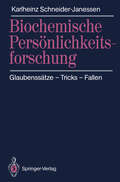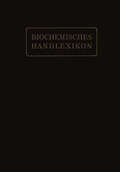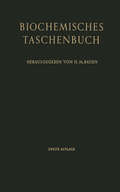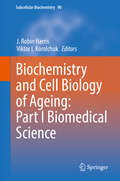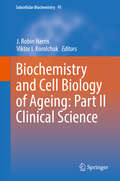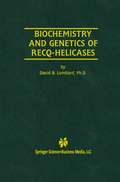- Table View
- List View
Biochemie - Regulation, Blut, Krankheitserreger
by Freya HarmjanzWenn Sie die Biochemie im Großen und Ganzen verstehen wollen, ohne Unmengen von Details auswendig zu lernen, sind Sie hier richtig. In diesem Buch beginnt jedes Kapitel mit einer verständlichen Abbildung für den Überblick, bevor es in die Tiefe geht. So laufen Sie nicht Gefahr, den Überblick zu verlieren.Bei der Erklärung der vielen Moleküle werden die Zusammenhänge innerhalb der Biochemie dargestellt und dabei die drei wichtigen Fragen beantwortet:· Woher kommt das Molekül?· Was macht es hier?· Wo geht es danach hin?Und für die Klinik gibt es Antwort auf die spannende Frage:· Was passiert eigentlich, wenn hier was schief geht?Da die Semesterklausuren häufig schwieriger sind als das Examen, legt das Buch seinen Schwerpunkt auf die Klausuren. So sind Sie für alle Fälle gut gerüstet. Und damit die Biochemie handlich bleibt, ist der Stoff auf drei Bücher verteilt:Zelle, Enzyme und praktische BiochemieEnergiestoffwechselRegulation, Blut, Krankheitserreger
Biochemie und Molekularbiologie: Eine Einführung in 40 Lerneinheiten
by Philipp Christen Rolf Jaussi Roger BenoitDiese Einführung in die Biochemie und Molekularbiologie ist für alle geschrieben, die sich für die molekularen Aspekte der Lebensvorgänge interessieren, insbesondere für Studierende der Medizin und der Naturwissenschaften, denen die Biochemie als Grundlagenwissenschaft dient. Die 40 kurzen Kapitel können weitgehend unabhängig voneinander benutzt werden. Mit seinem hohen Bildanteil setzt das Buch auf visuelles Lernen. Zu jedem Kapitel gibt es eine ausführliche, kommentierte Linksammlung, die u.a. Bildmaterial, Animationen, Datenbanken sowie Merksätze und Kontrollfragen enthält. Die Inhalte der Website können über QR-Codes im Buch, aber auch über die Webadresse abgerufen werden. Das Lehrbuch basiert auf dem 2005 von den Autoren veröffentlichten Titel Biochemie. Der Text ist korrigiert, ergänzt und gestrafft worden.
Biochemie und Pathobiochemie (Springer-Lehrbuch)
by Georg Löffler Petro E. PetridesAktuell, zuverlässig und ausgewogen - der neue Löffler/Petrides ist auch weiterhin Garant für höchste wissenschaftliche Kompetenz.Neu ist die schlüssige Didaktik und das farbige Layout mit zahlreichen Abbildungen. Neu ist auch die starke Verknüpfung der theoretischen Inhalte mit der klinischen Praxis.Den Lesern wird viel geboten: Interessante Einleitungen, eine klare Strukturierung des Inhalts, Hervorhebung der wesentlichen Stichworte, Merksätze, die sich als roter Faden durch den Text ziehen, prägnante Zusammenfassungen. Aktuelle Forschungsergebnisse und ein umfangreiches Register gehören selbstverständlich auch dazu. Lernpsychologisch optimal gestaltet und als Nachschlagewerk topaktuell!
Biochemie und Pathobiochemie (Springer-Lehrbuch)
by Georg Löffler Petro E. PetridesAktuell, zuverlässig und ausgewogen - der Löffler/Petrides ist Garant für höchste wissenschaftliche Kompetenz.Die schlüssige Didaktik überzeugt ebenso wie das farbige Layout mit zahlreichen Abbildungen. Dabei wurde besonderes Gewicht auf die starke Verknüpfung der theoretischen Inhalte mit der klinischen Praxis gelegt.Den Lesern wird viel geboten: Interessante Einleitungen, eine klare Strukturierung des Inhalts, Hervorhebung der wesentlichen Stichworte, Merksätze und prägnante Zusammenfassungen. Aktuelle Forschungsergebnisse und ein umfangreiches Register gehören selbstverständlich auch dazu. Lernpsychologisch optimal gestaltet und auch als Nachschlagewerk topaktuell.
Biochemie und Pathobiochemie (Springer-Lehrbuch)
"Der Löffler/Petrides ist das, was sich jeder Student wünscht: Ein topaktuelles Lehrbuch, das zu jeder erdenklichen Frage eine Antwort parat hat."(Studentenzitat)Neu: Das Standardwerk der Biochemie wurde von 22 renommierten Experten in jeder Hinsicht runderneuert: - Die enge Verknüpfung von theoretischen Inhalten und klinischer Praxis wird noch überzeugender herausgestellt. Die großzügige Ausstattung mit aussagekräftigen Abbildungen erleichtern den Zugang zu komplizierten biochemischen Zusammenhängen. Konsequent klar strukturierte und gewichtete Inhalte steuern den Lernprozess, unterstützt durch einprägsame Merksätze, aktuelle Infoboxen, zusammenfassende Kernaussagen, Schlüsselbegriffe und ein umfangreiches Register. Unser Angebot: Aktualität, Ausgewogenheit und Zuverlässigkeit.
Biochemie - Zelle, Enzyme, Praktische Biochemie
by Freya HarmjanzWenn Sie die Biochemie im Großen und Ganzen verstehen wollen, ohne Unmengen von Details auswendig zu lernen, sind Sie hier richtig. In diesem Buch beginnt jedes Kapitel mit einer verständlichen Abbildung für den Überblick, bevor es in die Tiefe geht. So laufen Sie nicht Gefahr, den Überblick zu verlieren. Bei der Erklärung der vielen Moleküle werden die Zusammenhänge innerhalt der Biochemie dargestellt und dabei die drei wichtigen Fragen beantwortet: · Woher kommt das Molekül?· Was macht es hier?· Wo geht es danach hin? Und für die Klinik gibt es Antwort auf die spannende Frage: · Was passiert eigentlich, wenn hier was schief geht? Da die Semesterklausuren häufig schwieriger sind als das Examen, legt das Buch seinen Schwerpunkt auf die Klausuren. So sind Sie für alle Fälle gut gerüstet. Und damit die Biochemie handlich bleibt, ist der Stoff auf drei Bände verteilt: Band 1 Zelle, Enzyme und praktische Biochemie Band 2 Energiestoffwechsel Band 3 Regulation, Blut, Krankheitserreger
Biochemische Persönlichkeitsforschung: Glaubenssätze — Tricks — Fallen
by Karlheinz Schneider-JanessenIst Wissenschaft irrational? Karlheinz Schneider-Janessen hat diese Frage für die biologisch orientierte Psychiatrie mit einem klaren Ja beantwortet. In den anderen Wissenschaften ist es zwar ebenso. Doch verschärft sich dieses Problem in der Medizin. Denn aus unreifen wissenschaftlichen Vorstellungen sind im letzten Jahrhundert oft allzu rasch falsche therapeutische Konsequenzen gezogen worden. Und dies geschieht - so ist zu befürchten - auch heute noch. Ein sehr kritisches, manchmal auch böses, aber doch notwendiges Buch. Ein Schmunzelbuch für jeden Wissenschafts-Skeptiker. Ein Lesebuch für Wissenschaftler allemal.
Biochemisches Handlexikon: V. Band: Alkaloide, Tierische Gifte, Produkte der inneren Sekretion, Antigene, Fermente
by H. Altenburg I. Bang K. Bartelt Fr. Baum C. Brahm W. Cramer K. Dieterich R. Ditmar M. Dohrn H. Einbeck H. Euler E. St. Faust C. Funk O. v. Fürth O. Gerngross V. Grafe J. Helle O. Hesse K. Kautzsch Fr. Knoop R. Kobert J. Lundberg C. Neuberg M. Nierenstein O. A. Oesterle Th. B. Osborne L. Pincussohn H. Pringsheim K. Raske B. v. Reinbold Br. Rewald A. Rollett P. Rona H. Rupe Fr. Samuely H. Scheibler J. Schmid J. Schmidt E. Schmitz M. Siegfried E. Strauss A. Thiele G. Trier W. Weichardt R. Willstätter A. Windaus E. Winterstein Ed. Witte G. Zemplén E. Zunz Emil AbderhaldenDieser Buchtitel ist Teil des Digitalisierungsprojekts Springer Book Archives mit Publikationen, die seit den Anfängen des Verlags von 1842 erschienen sind. Der Verlag stellt mit diesem Archiv Quellen für die historische wie auch die disziplingeschichtliche Forschung zur Verfügung, die jeweils im historischen Kontext betrachtet werden müssen. Dieser Titel erschien in der Zeit vor 1945 und wird daher in seiner zeittypischen politisch-ideologischen Ausrichtung vom Verlag nicht beworben.
Biochemisches Handlexikon: IX. Band (2. Ergänzungsband)
by Andor Fodor Dions Fuchs Paul Hirsch Thomas B. Osborne Béla v. Reinbold Arthur Weil Géza ZemplénDieser Buchtitel ist Teil des Digitalisierungsprojekts Springer Book Archives mit Publikationen, die seit den Anfängen des Verlags von 1842 erschienen sind. Der Verlag stellt mit diesem Archiv Quellen für die historische wie auch die disziplingeschichtliche Forschung zur Verfügung, die jeweils im historischen Kontext betrachtet werden müssen. Dieser Titel erschien in der Zeit vor 1945 und wird daher in seiner zeittypischen politisch-ideologischen Ausrichtung vom Verlag nicht beworben.
Biochemisches Taschenbuch
by R. Kuhn H. M. RauenDem "Taschenbuch für Chemiker und Physiker" ein Taschenbuch für Bio chemiker an die Seite zu stellen, entspricht einem Bedürfnis unserer Zeit. Man kann es zwar nicht in die Tasche seines Rockes stecken, und es wendet sich auch nicht allein an diejenigen, welche die Biochemie als Lehrfach vertreten oder sich selbst als Biochemiker bezeichnen. Sein Titel wird ungeachtet dessen weithin verständlich sein. Der Hauptwert dieses Taschenbuches liegt meines Erachtens einerseits darin, daß es in Laboratorien, die vorzugsweise biochemische bzw. physiologisch chemische Fragen bearbeiten, am Arbeitstisch zur Hand ist und damit in zahllosen Fällen den Weg in die Bibliothek zu den großen Haridbüchern und)lachschlage werken ersparen kann; andererseits darin, daß es auch zu Hause und in Biblio theken, die über keine einschlägigen großen Nachschlagewerke verfügen, eine erste Unterrichtung leicht macht. Möge das vorliegende Werk die chemische Erforschung des Lebendigen fördern und darüber hinaus ein Ratgeber werden für die vielen, welche im Rahmen unseres Wirtschaftslebens mit Pflanzen, Tieren und Mikroorganismen zu tun haben und deren Produkte weiter verarbeiten. Möge es nicht zuletzt auch seinen Weg in die Kliniken nehmen, den Arzt beraten und damit den. Kranken helfen. Heidelberg, den 1. Oktober 1956 Richard Kuhn Vorwort.
Biochemisches Taschenbuch
by Marianne Rauen-BuchkaDem "Taschenbuch für Chemiker und Physiker" ein Taschenbuch für Bio chemiker an die Seite zu stellen, entspricht einem Bedürfnis unserer Zeit. Man kann es zwar nicht in die Tasche seines Rockes stecken, und es wendet sich auch trlcht allein an diejenigen, welche die Biochemie als Lehrfach vertreten oder sich selbst als Biochemiker bezeichnen. Sein Titel wird ungeachtet dessen weithin verständlich sein. Der Hauptwert dieses Taschenbuches liegt meines Erachtens einerseits darin, daß es in Laboratorien, die vorzugsweise biochemische bzw. physiologisch chemische Fragen bearbeiten, am Arbeitstisch zur Hand ist und damit in zahllosen Fällen den Weg in die Bibliothek zu den großen Handbüchern und Nachschlage werken ersparen kann; andererseits darin, daß es auch zu Hause und in Biblio theken, die über keine einschlägigen großen Nachschlagewerke verfügen, eine erste Unterrichtung leicht macht. Möge das vorliegende Werk die chemische Erforschung des Lebendigen fördern und darüber hinaus ein Ratgeber werden für die Vielen, welche im Rahmen unseres Wirtschaftslebens mit Pflanzen, Tieren und Mikroorganismen zu tun haben und deren Produkte weiter verarbeiten. Möge es nicht zuletzt auch seinen Weg in die Kliniken nehmen, den Arzt beraten und damit den Kranken helfen.
Biochemistry
by Raymond S. OchsBiochemistry Second Edition, is a single-semester text designed for undergraduate non-biochemistry majors. Accessible, engaging, and informative, it is the perfect introduction to the subject for students who may approach chemistry with apprehension. Its unique emphasis on metabolism and its kinetic underpinnings gives the text up-to-the-minute relevance for students investigating current public health concerns, such as obesity and diabetes. Biochemistry Second Edition will encourage students to explore the basics of chemistry and its influence on biological problems. Key Features: Provides an understanding of (mostly) enzymatic reactions that are responsible for the function and maintenance of living things. This innovative text for non-biochemistry majors includes introductory material at the beginning of each chapter that contextualizes chapter themes in real-life scenarios. Online supporting materials with further opportunities for research and investigation. Synthesis questions at the end of each chapter that encourage students to make connections between concepts and ideas, as well as develop critical-thinking skills. About the Author: Raymond S. Ochs is a biochemist with a career-long specialty in metabolism spanning 30 years. Previously, he has written the textbook Biochemistry, contributed the metabolism chapters to another text, Principles of Biochemistry, and co-edited a collection of articles published as Metabolic Regulation, and the recent monograph Metabolic Strucure and Regulation. His research interests concern major pathways of liver and muscle, including glycolysis, gluconeogenesis, ureogenesis, fatty acid metabolism, glycogen metabolism, and control by cAMP, Ca2+, diacylglycerol, and AMPK. He is currently professor of pharmacy at St. John’s University in New York, teaching biochemistry, physiology, and medicinal chemistry.
Biochemistry
by Raymond S. OchsBiochemistry Second Edition, is a single-semester text designed for undergraduate non-biochemistry majors. Accessible, engaging, and informative, it is the perfect introduction to the subject for students who may approach chemistry with apprehension. Its unique emphasis on metabolism and its kinetic underpinnings gives the text up-to-the-minute relevance for students investigating current public health concerns, such as obesity and diabetes. Biochemistry Second Edition will encourage students to explore the basics of chemistry and its influence on biological problems. Key Features: Provides an understanding of (mostly) enzymatic reactions that are responsible for the function and maintenance of living things. This innovative text for non-biochemistry majors includes introductory material at the beginning of each chapter that contextualizes chapter themes in real-life scenarios. Online supporting materials with further opportunities for research and investigation. Synthesis questions at the end of each chapter that encourage students to make connections between concepts and ideas, as well as develop critical-thinking skills. About the Author: Raymond S. Ochs is a biochemist with a career-long specialty in metabolism spanning 30 years. Previously, he has written the textbook Biochemistry, contributed the metabolism chapters to another text, Principles of Biochemistry, and co-edited a collection of articles published as Metabolic Regulation, and the recent monograph Metabolic Strucure and Regulation. His research interests concern major pathways of liver and muscle, including glycolysis, gluconeogenesis, ureogenesis, fatty acid metabolism, glycogen metabolism, and control by cAMP, Ca2+, diacylglycerol, and AMPK. He is currently professor of pharmacy at St. John’s University in New York, teaching biochemistry, physiology, and medicinal chemistry.
Biochemistry: An Organic Chemistry Approach
by Michael B. Smith&“There is a continuing demand for up to date organic & bio-organic chemistry undergraduate textbooks. This well planned text builds upon a successful existing work and adds content relevant to biomolecules and biological activity&”. -Professor Philip Page, Emeritus Professor, School of Chemistry University of East Anglia, UK &“Introduces the key concepts of organic chemistry in a succinct and clear way&”. -Andre Cobb, KCL, UK Reactions in biochemistry can be explained by an understanding of fundamental organic chemistry principles and reactions. This paradigm is extended to biochemical principles and to myriad biomolecules. Biochemistry: An Organic Chemistry Approach provides a framework for understanding various topics of biochemistry, including the chemical behavior of biomolecules, enzyme activity, and more. It goes beyond mere memorization. Using several techniques to develop a relational understanding, including homework, this text helps students fully grasp and better correlate the essential organic chemistry concepts with those concepts at the root of biochemistry. The goal is to better understand the fundamental principles of biochemistry. Features: Presents a review chapter of fundamental organic chemistry principles and reactions. Presents and explains the fundamental principles of biochemistry using principles and common reactions of organic chemistry. Discusses enzymes, proteins, fatty acids, lipids, vitamins, hormones, nucleic acids and other biomolecules by comparing and contrasting them with the organic chemistry reactions that constitute the foundation of these classes of biomolecules. Discusses the organic synthesis and reactions of amino acids, carbohydrates, nucleic acids and other biomolecules.
Biochemistry: An Organic Chemistry Approach
by Michael B. Smith&“There is a continuing demand for up to date organic & bio-organic chemistry undergraduate textbooks. This well planned text builds upon a successful existing work and adds content relevant to biomolecules and biological activity&”. -Professor Philip Page, Emeritus Professor, School of Chemistry University of East Anglia, UK &“Introduces the key concepts of organic chemistry in a succinct and clear way&”. -Andre Cobb, KCL, UK Reactions in biochemistry can be explained by an understanding of fundamental organic chemistry principles and reactions. This paradigm is extended to biochemical principles and to myriad biomolecules. Biochemistry: An Organic Chemistry Approach provides a framework for understanding various topics of biochemistry, including the chemical behavior of biomolecules, enzyme activity, and more. It goes beyond mere memorization. Using several techniques to develop a relational understanding, including homework, this text helps students fully grasp and better correlate the essential organic chemistry concepts with those concepts at the root of biochemistry. The goal is to better understand the fundamental principles of biochemistry. Features: Presents a review chapter of fundamental organic chemistry principles and reactions. Presents and explains the fundamental principles of biochemistry using principles and common reactions of organic chemistry. Discusses enzymes, proteins, fatty acids, lipids, vitamins, hormones, nucleic acids and other biomolecules by comparing and contrasting them with the organic chemistry reactions that constitute the foundation of these classes of biomolecules. Discusses the organic synthesis and reactions of amino acids, carbohydrates, nucleic acids and other biomolecules.
Biochemistry and Biology of Coronaviruses (Advances in Experimental Medicine and Biology #142)
by V. Ter MeulenThis book is the result of an international symposium held at the Institute of Virology and Immunobiology of the-University of WUrzburg, Germany, in October 1980. The intent of this symposium was to provide an opportunity to compare the data on coronavirus structure and replica tion as well as to discuss mechanisms of pathogenesis. For over a decade coronaviruses have been recognized as an important group of viruses which are responsible for a variety of diseases of clinical importance in animals and man. Recently new and interesting data on the molecular biology and pathogenesis of coronaviruses have become available and this led us to organize this meeting. The uniformity and diversity in this virus group was evaluated from a molecular point of view and the replication of coronaviruses appears to involve aspects which may be unique for this virus group. Additionally, in contrast to other positive strand RNA viruses it became clear that coronaviruses readily establish persistent infections in the host, a phenomenon which may lead to the different subacute or chronic disorders manifested during coronavirus infection. This volume presents a series of articles based upon the scientific presentation given at the symposium. In addition, there are two articles by B. W. J. Mahy and D. A. J. Tyrrell which summarize the current state of art concerning the biochemistry and biology of coronaviruses, respective ly. We believe this book will be of interest to all virologists and particularly to both established workers and newcomers to this field. V.
Biochemistry and Cell Biology of Ageing: Part I Biomedical Science (Subcellular Biochemistry #90)
by J. Robin Harris Viktor I. KorolchukThis new volume in the Subcellular Biochemistry series will focus on the biochemistry and cellular biology of aging processes in human cells. The chapters will be written by experts in their respective fields and will focus on a number of the current key areas of research in subcellular aging research. Main topics for discussion are mitochondrial aging, protein homeostasis and aging and the genetic processes that are involved in aging. There will also be chapters that are dedicated to the study of the roles of a variety of vitamins and minerals on aging and a number of other external factors (microbiological, ROS, inflammation, nutrition). This book will provide the reader with a state of the art overview of the subcellular aging field. This book will be published in cooperation with a second volume that will discuss the translation of the cell biology of aging to a more clinical setting and it is hoped that the combination of these two volumes will bring a deeper understanding of the links between the cell and the body during aging.
Biochemistry and Cell Biology of Ageing: Part II Clinical Science (Subcellular Biochemistry #91)
by J. Robin Harris Viktor I. KorolchukThis volume of the subcellular Biochemistry series will attempt to bridge the gap between the subcellular events that are related to aging as they were described in the first volume of this set of two books and the reality of aging as this is seen in clinical practice. All chapters will start from the biochemistry or cell biology, where the data is available and work up towards the understanding that we have of aging in the various areas that are related to the subject. Key focus points for this volume are nutrition, external factors and genetics on aging. There will also be chapters that will focus on various organs or tissues in which aging has been well studied, like the eyes, the muscles, the immune system and the bones. The aim of the book project and the book project that is published in concert with this volume is to bring the subcellular and clinical areas into closer contact.
Biochemistry and Cell Biology of Ageing: Part III Biomedical Science (Subcellular Biochemistry #102)
by J. Robin Harris Viktor I. KorolchukThis book provides a state-of-the-art overview of key areas of subcellular aging research in human cells. The reader is introduced to the historical development and progress in biomedical aging research and learns, for example, about the role of microRNAs, circRNAs, mitochondria and extracellular vesicles in cellular senescence. The reader will also learn more about how gap junctions, the nuclear pore complex and the proteasome are affecting the ageing processes. In addition, novel therapeutic opportunities through modulation of cellular senescence are discussed. The book follows on from Parts I and II of Biochemistry and Cell Biology of Ageing (Volumes 90 and 91 of the Subcellular Biochemistry book series) by covering interesting and significant biomedical ageing topics not included in the earlier volumes. Comprehensive and cutting-edge, this book is a valuable resource for experienced researchers and early career scientist alike, who are interested in learning more about the fascinating and challenging question of why and how our cells age.
Biochemistry and Cell Biology of Ageing: Part IV, Clinical Science (Subcellular Biochemistry #103)
by J. Robin Harris Viktor I. KorolchukThis book provides an up-to-date overview of key areas of ageing research and bridges the gap between the subcellular events and the reality of ageing as seen in clinical practice.To this end, the reader learns about the historical development and progression of clinical ageing research. All chapters address the biochemistry or cell biology of various ageing events (to the extent that the data are available) and work their way to the clinical understanding we have of ageing. The focus of this volume is on how dietary restriction, virus infection and chronic inflammation affect the ageing process. Additionally, this book discusses how phosphate metabolism and metabolic dysfunction contribute to ageing events and how various organs and tissues (e.g. tendons, ears, heart muscle, and the endocrine system) age. This book follows on from Parts I, II and III of Biochemistry and Cell Biology of Ageing within the Subcellular Biochemistry book series and aims to bring the subcellular and clinical areas into closer contact by including interesting and significant biomedical ageing topics that were not included in the earlier volumes. Comprehensive and cutting-edge, this book is a valuable resource for experienced researchers and early career scientist alike, who are interested in learning more about the fascinating and challenging question of why and how our cells age.
Biochemistry and Genetics of Recq-Helicases
by David B. LombardBiochemistry And Genetics of RecQ-Helicases provides a background into the role of helicases in general and RecQ helicases specifically in DNA repair. Helicases- enzymes which break down hydrogen bonds between nucleic acid strands in a nucleoside triphosphate-dependent manner-are ubiquitous in biology, participating in processes as diverse as replication, repair, recombination, transcription, and translation. The RecQ-family helicases are a group of helicases which have important roles in the maintenance of genomic stability in many organisms. In humans, mutations in three RecQ-family helicases lead to disease. This book thoroughly examines these helicases. Mutations in the BLM gene lead to Bloom syndrome, a disorder characterized by a susceptibility to many types of cancer. Mutations in the WRN gene cause Werner syndrome, a disease which in some respects resembles premature aging. Finally, mutations in a newly characterized RecQ-family member, RECQ4, may lead to the very rare recessive disorder Rothmund-Thomson syndrome, a condition characterized by developmental abnormalities and some aging-like manifestations. This book is intended for any researchers invested in these particular disorders, or with a general interest in DNA.
Biochemistry and Metabolism
by Anthony J. SbarraThis comprehensive treatise on the reticuloendothelial system is a project jointly shared by individual members of the Reticuloendothelial (RE) Society and bio medical scientists in general who are interested in the intricate system of cells and molecular moieties derived from these cells which constitute the RES. It may now be more fashionable in some quarters to consider these cells as part of what is called the mononuclear phagocytic system or the lymphoreticular system. Nevertheless, because of historical developments and current interest in the subject by investigators from many diverse areas, it seems advantageous to present in one comprehensive treatise current information and knowledge con of the RES, such as morphology, biochemistry, phylogeny cerning basic aspects and ontogeny, physiology, and pharmacology as well as clinical areas including immunopathology, cancer, infectious diseases, allergy, and hypersensitivity. It is anticipated that by presenting information concerning these apparently heterogeneous topics under the unifying umbrella of the RES attention will be focused on the similarities as well as interactions among the cell types constitut ing the RES from the viewpoint of various disciplines. The treatise editors and their editorial board, consisting predominantly of the editors of individual vol umes, are extremely grateful for the enthusiastic cooperation and enormous task undertaken by members of the biomedical community in general and especially by members of the American as well as European and Japanese Reticuloendothe lial Societies.








